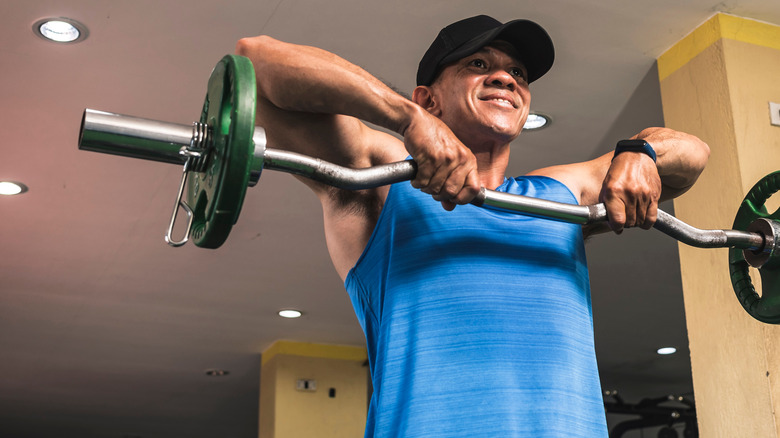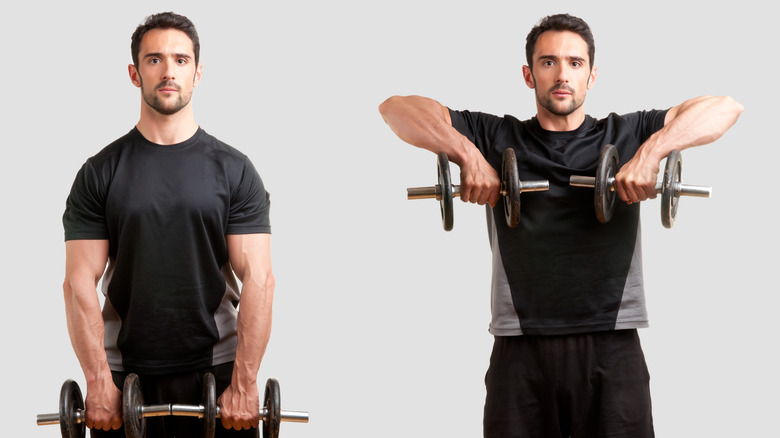Think Twice Before Doing Upright Rows At The Gym. Here's Why
Upright rows have been a staple in the fitness community for years. Some athletes swear by them for bigger shoulders and increased upper body strength. This compound movement primarily engages your side delts, but you will also use your front deltoids, traps, biceps, triceps, and upper back muscles to pull the weight up, notes ExRx. Its versatility is hard to beat. You can perform upright rows with a barbell, kettlebell, dumbbells, cables, or resistance bands, depending on your fitness level and personal preferences.
The upright row is one of the few compound exercises for the shoulders. Simply put, it engages multiple muscle groups — not just your delts. The same goes for shoulder presses, which engage your traps, chest, and arm muscles in addition to the anterior and lateral deltoids (via ExRx). Front and lateral raises, on the other hand, isolate your delts.
Ideally, you should use both compound and isolation exercises to work your shoulders from different angles. "I like to use upright rows as my finishing movement," said professional bodybuilder Garrett Downing in an interview with Muscle and Fitness. "It really gives me a great overall pump across my traps and shoulders," he added.
But despite its potential benefits, this shoulder exercise can lead to painful injuries — and that's why you should think twice before doing upright rows.
Upright rows can hurt your wrists and shoulders
This compound movement is performed by pulling the weight to the front of your shoulders from a standing position. For example, if you are using a barbell, you'll lift it toward your upper chest by pulling through your elbows. Most gym-goers use a narrow grip, but there's nothing wrong with placing your hands further apart from each other. According to Muscle and Fitness, using a wider-than-shoulder-width grip may help prevent rotator cuff injuries and lead to better results.
Speaking of injuries, upright rows put your shoulder in an unnatural position, says strength and conditioning coach Tom MacCormick (via T-Nation). The barbell version poses the highest risk. Since your hands are fixed on the bar, you cannot move through a full range of motion. On top of that, you may end up putting stress on your shoulders. Over time, these issues may increase your risk of shoulder and wrist injuries.
"Upright rows have a bad reputation because they put us in shoulder abduction and shoulder internal rotation. Due to our functional anatomy, this position really limits the space between our humerus and acromion in our 'shoulder joint.' For some, this 'impingement' caused by lack of space can cause irritation and pain," explained performance enhancement specialist Tommy Hockenjos in an interview with Byrdie. But it's possible to mitigate this risk by using proper lifting form.
How to safely perform an upright row
The upright row isn't the best option for those with shoulder pain or previous injuries, but you can make some adjustments to reduce injury risk. For starters, use a wider grip and draw your shoulder blades back, recommends Hockenjos (via Byrdie). Another option is to use dumbbells and lift one arm at a time. You may also use a rope attachment or straight bar on the cable machine, as it allows you to vary your grip width and protect your shoulders.
Using a shorter range of motion may help, too. Ideally, stop just below shoulder height when lifting the weight, suggests certified strength and conditioning specialist Ebenezer Samuel (via Men's Health). He also recommends swapping the barbell or EZ curl bar for dumbbells. "By stopping with your elbows slightly below your shoulders, you're essentially mimicking a lateral raise, with a shorter lever," says Samuel.
Remember that upright rows are not your only option. From barbell high pulls to lateral raises and seated snatches, there are safer alternatives available. Another great choice is the TRX YTW, which engages pretty much the same muscle groups as the upright row, according to Powerlifting Technique. Plus, it's suitable for at-home workouts. Other exercises, such as the single-arm dumbbell power snatch, can increase shoulder size and strength while building explosive power.



